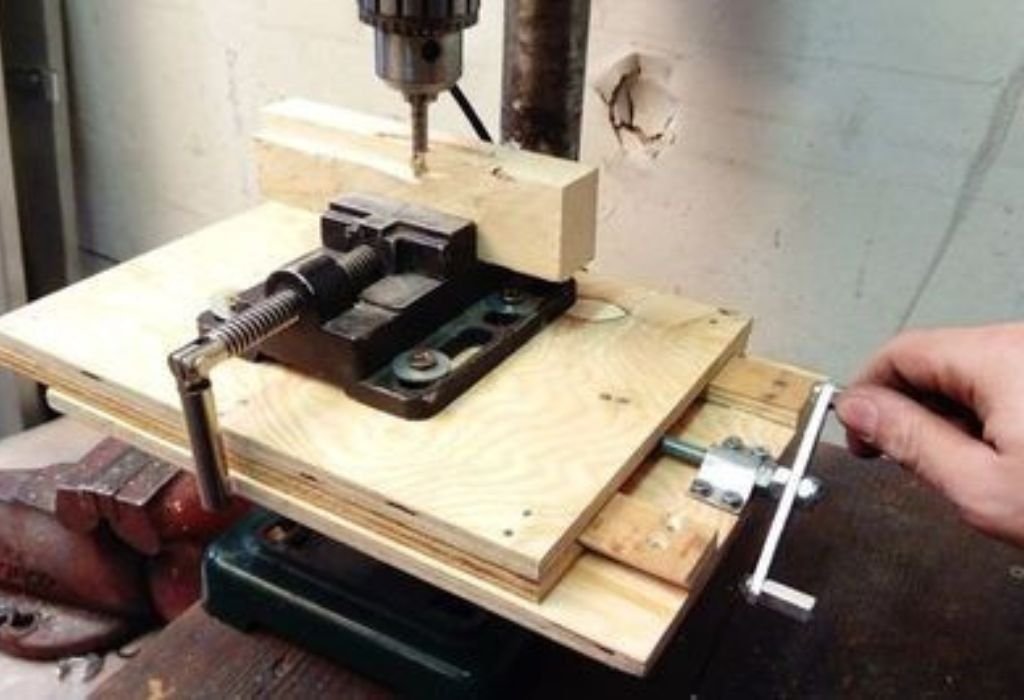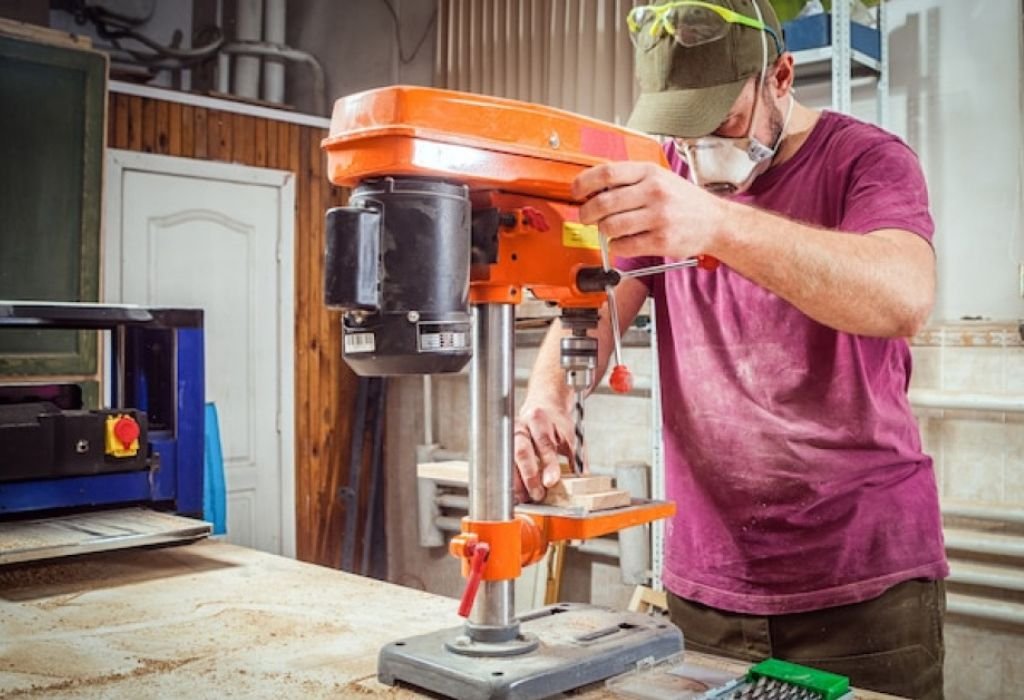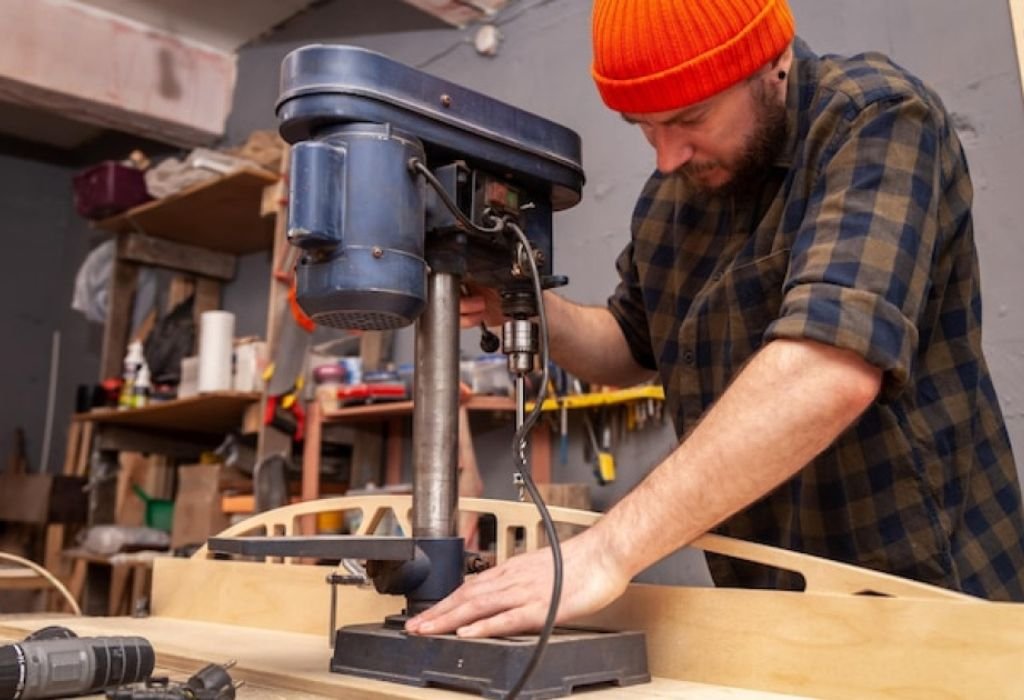Every DIY workshop has a few essentials — a sturdy bench, a reliable set of bits, and a trusted drill press ready to bore holes with perfect precision. But when a project calls for cutting slots, shaping metal, or trimming edges, the same question often surfaces: can a drill press be used as a mill machine?
At first glance, both tools seem similar. They spin cutting tools, use vertical motion, and promise accuracy. It’s no wonder that many hobby machinists try to bridge the gap, hoping their drill press can handle light milling tasks without investing in a separate machine.
However, what looks like a simple upgrade can quickly become a mechanical challenge. A drill press isn’t designed to handle side forces — and those lateral stresses are exactly what milling requires. Without the right rigidity or bearings, even a light side cut can cause tool deflection or damage to the spindle assembly.
According to a survey by The Home Shop Machinist Forum, nearly 37% of DIY metalworkers have tried using their drill press for light milling, but most reported issues with vibration or accuracy (source). Another machining guide from Rong Fu Industrial Co. notes that improper side-loading can reduce drill press bearing life by over 50% (source).
This article breaks down whether it’s truly possible to mill with a drill press, what risks are involved, and how far you can safely push the limits. By the end, you’ll know exactly when it’s practical — and when it’s time to consider a real milling machine.
Drill Press vs Milling Machine — Definitions & Key Differences

Before deciding whether a drill press can act as a mill, it’s essential to understand what sets these two machines apart. Both may use similar cutting tools, but their design, power, and purpose are completely different.
A drill press is engineered for vertical accuracy. It drills holes straight down along the Z-axis, applying consistent downward pressure.
A milling machine, however, is designed to cut along multiple axes — X, Y, and Z — allowing it to remove material sideways or diagonally. That versatility makes it ideal for shaping, slotting, and contouring hard materials.
The core difference lies in the spindle and bearing system. Milling machines use rigid spindles with heavy-duty bearings to resist both vertical and lateral loads. A drill press’s bearings are only designed for axial pressure. When side forces are applied, they wear quickly or fail.
According to Machine Design Review (2024), a milling spindle can handle up to five times more lateral load than a standard drill press spindle (source). This distinction determines whether your tool stays accurate or breaks down under stress.
What is the main purpose of a drill press?
A drill press is built for vertical hole-making with controlled depth and accuracy.
What makes a milling machine different?
A milling machine removes material in multiple directions using precise, rigid movement along X, Y, and Z axes.
Can a drill press handle side loads like a mill?
No. Its spindle and bearings are not designed for side-cutting stress.
Why is rigidity important in milling?
Because side forces can cause deflection and chatter, leading to poor finishes and tool breakage.
Is a milling machine more versatile?
Yes. It can drill, slot, contour, and face materials with higher precision and stability.
Why Many Ask: Can a Drill Press Be Used as a Mill Machine?
Many DIY builders and hobby machinists consider converting their drill press for light milling. The motivation often comes from budget and space limitations.
Buying a milling machine can be expensive and requires dedicated space. A drill press already exists in most workshops, so using it for light cuts feels like a practical shortcut.
Online forums are filled with discussions about makeshift conversions, modified arbors, and XY tables. Some even post success stories after minor upgrades, especially when working with wood or soft metals.
Yet, many experienced machinists caution that this shortcut can be dangerous. The lack of lateral stiffness and proper clamping increases the risk of vibration, tool slippage, and inaccurate results.
Why attempt milling with a drill press?
To save money, space, or experiment with small projects before buying a mill.
Which materials are typically attempted?
Softer materials such as aluminum, wood, brass, and plastic.
What limitations exist?
Lack of side-load capacity, weak bearings, and unstable feed control.
Are there machines that combine both functions?
Yes, mill-drill hybrids exist, designed to safely perform both drilling and light milling.
What do experts say about conversions?
They warn that drill presses can perform only very light milling before damage becomes likely.
Technical Challenges and Risks
Using a drill press as a mill might seem harmless, but the mechanical challenges are serious. Milling generates side forces that the drill press simply isn’t built to handle.
Spindle bearings can wear out rapidly when subjected to lateral loads. Chatter and vibration increase, making cuts uneven and reducing tool life.
The chuck taper can loosen because most drill presses lack drawbars. This can cause the chuck to slip or eject, damaging both the tool and the workpiece.
Feed control is another issue. Drill presses are not designed for continuous sideways feeding, which makes it hard to maintain consistent pressure.
Will side forces damage bearings?
Yes, side forces lead to premature bearing wear and spindle wobble.
Can the chuck slip during milling?
Yes, since there’s no drawbar to lock it, lateral stress can make it fall off.
Does vibration affect accuracy?
Absolutely. Even minor chatter reduces precision and can ruin the surface finish.
Can tool breakage occur easily?
Yes, excessive load or unstable feed can cause end mills to snap.
Is it safe to attempt heavy cuts?
No. Heavy cuts greatly increase the chance of bearing failure and workpiece accidents.
How Far Can It Actually Work?

While a drill press isn’t ideal for milling, some light tasks may be achievable under careful conditions.
For example, shallow face cuts or small slots on soft materials can be done safely if the load is kept minimal. A sturdy drill press, combined with a cross-slide vise or XY table, can help manage limited lateral motion.
Soft materials like plastic, wood, or aluminum are more forgiving. Steel or hardened alloys, however, can destroy bearings almost immediately.
Slow RPMs, short end mills, and shallow cuts can improve results slightly. Still, accuracy and surface finish will never match a real milling machine.
What type of milling is possible?
Only very light trimming, facing, or shallow slotting operations.
Which materials are safest to work with?
Soft materials such as wood, brass, and aluminum.
Can conversions improve performance?
Upgrades like stronger bearings or added bracing can help, but results remain limited.
Is precision achievable?
Not consistently — deflection and vibration reduce accuracy.
Should heavy materials be avoided?
Yes, steel or cast iron should never be milled on a drill press.
Step-by-Step Guide to Light Milling Conversion
If you still wish to experiment, a few upgrades can make your setup safer. Start by choosing a robust drill press with minimal spindle play.
Replace standard bearings with angular contact bearings, which can tolerate limited side pressure. Install a drawbar or lock the arbor to prevent the chuck from slipping.
Mount an XY cross-slide table or milling vise securely on the drill table. This gives controlled movement along X and Y axes.
Use the lowest possible spindle speed and take shallow passes. Always test on scrap first to check for vibration or spindle deflection.
Which bearing upgrades work best?
Angular contact or tapered roller bearings handle lateral load more effectively.
Why add a drawbar?
It prevents the chuck or arbor from dropping under load.
What does a cross-slide table do?
It provides controlled horizontal movement, similar to a milling table.
What feeds and speeds are safe?
Use slow RPM and feed gently to avoid chatter.
Should tests be done before real work?
Always — test cuts reveal vibration, rigidity issues, or misalignment early.
Alternatives and Better Options
Instead of risking damage, there are safer ways to achieve milling-like results.
Mill-drill combo machines are affordable and purpose-built for both operations. They include rigid bearings, proper drawbars, and stable XY tables.
Benchtop milling machines are another compact choice. They handle side cuts safely without taking up much space.
If you only need occasional precision cuts, consider using a CNC router or outsourcing to a small shop. These alternatives save both time and equipment wear.
What is a mill-drill combo?
A hybrid machine designed to perform drilling and light milling safely.
Is a benchtop mill a better investment?
Yes, it offers higher rigidity, accuracy, and safety.
Can CNC routers replace a mill?
They can for light materials but are not suitable for heavy metal milling.
When is outsourcing the better choice?
When tolerances are tight or materials are too hard for DIY setups.
Are there portable milling solutions?
Yes, small bench mills and modular CNC units work for light projects.
Best Practices for Attempting Light Milling

If you experiment with light milling on a drill press, safety and precision must come first.
Always clamp your workpiece securely using a milling vise or T-slot clamps. Never hold material by hand.
Use sharp cutting tools and take shallow cuts. Keep spindle speed low and increase only if chatter stops.
Apply lubrication or coolant to minimize heat and tool stress. Regularly inspect the spindle and bearings for looseness.
Stop immediately if vibration, tool deflection, or unusual noise occurs. These are early signs of excessive stress or bearing failure.
How should the workpiece be secured?
Always use clamps or vises — never rely on hand pressure.
What spindle speed works best?
Low RPM is safest; increase gradually only if vibration decreases.
When should you stop cutting?
At the first sign of chatter or spindle instability.
How can tool life be extended?
Keep tools sharp and lubricated, and avoid deep cuts.
Should maintenance be frequent?
Yes, bearings, chuck tightness, and table alignment should be checked after every session.
Conclusion
So, can a drill press be used as a mill machine? The answer is only to a very limited extent.
A drill press can handle light surface cuts on soft materials when used carefully, but it’s not built for true milling operations. The lack of lateral strength, rigid bearings, and controlled feed makes precision nearly impossible.
If you plan to work on harder materials or need accurate, repeatable results, investing in a proper milling machine or a mill-drill combo is the smarter choice. It ensures safety, consistency, and long-term reliability.
For hobbyists, light experiments can be a learning experience — but for professional results, a real mill is the only reliable tool.

I’m John F. Nicholas, the founder, lead writer, and drill enthusiast behind 101drill.com. With years of hands-on experience in power tools and DIY projects, I created this platform to share practical knowledge, expert tips, and real-world insights to help others master the art of drilling.
